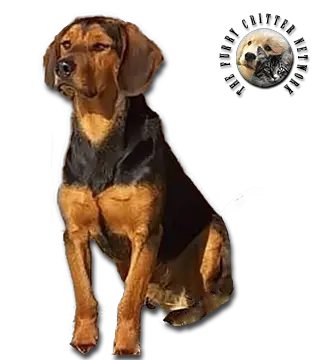Breed Standard
Head: Wide. Broad, slightly domed skull. Pronounced stop. Straight muzzle. Short lips.
Ears: Set on high, wide, rounded at the tips.
Eyes: Round, dark brown.
Body: Slightly longer than it is tall. Well-knit neck without dewlap. Pronounced withers. Well-domed, moderately wide, well let-down chest. Slight tuck-up. Broad, long, moderately sloping croup. Firm, straight back.
Tail: Set on high, long. Carried high in action. A brush tail with dense hair is prized.
Hair: Fairly thick, lying close to the body. Pronounced culottes on the thighs. Undercoat.
Coat: Fawn or black and tan, tricolor. Fawn (red to yellowish-red) or black and tan (black mantle) varieties have well-defined reddish-tan markings on the legs, chest, abdomen, and head. Both varieties may have white markings (collar, chest, legs, and feet).
Size: Dog: 44 to 50 cm. (17-20 in).Bitch: 42 to 48 cm. (16.5-19 in).
Weight: Approx. 20 kg (44 lb).
History
The Tyrolean Hound, also known as the Tyroler Bracke, is a breed of scent hound originally developed in the 1800s from the Bracke hounds and the Celtic hounds. It was first bred in Tyrol as a dog adapted to hunting in the snow. Emperor Maximilian I used this hound for hunting hare and fox and for tracking wounded game. Breeding began in 1860, and then in 1896 the first standard of breeding was published. Followed shortly thereafter, the Tyrolean Hound was recognized as their own breed in 1908. It was not until 2006, that the Tyrolean Hound was recognized by the United Kennel Club.
Behavior
This versatile scenthound hunts hare and fox and is used as a bloodhound. He is well-suited to hunting in the forest or the mountains. He has a very keen nose, a good voice, and an even temper. He is an affectionate companion.
The Tyrolean Hound needs space and exercise.
Function
Hunting Dog.
Health
Being a hunting breed, the dog has the tendency to get extremely muddy and dirty after it has been on a hunting trip. The dog may also pick up thorns and external parasites. It is necessary to check and clean and even bathe the dog after it has been hunted. Dogs that are kept as a house companion do not need frequent bathing. Grooming would be as easy as brushing the dog’s coat once a week.
Known issues to look for:
Hip dysplasia
Hunting injuries
Ear infections






